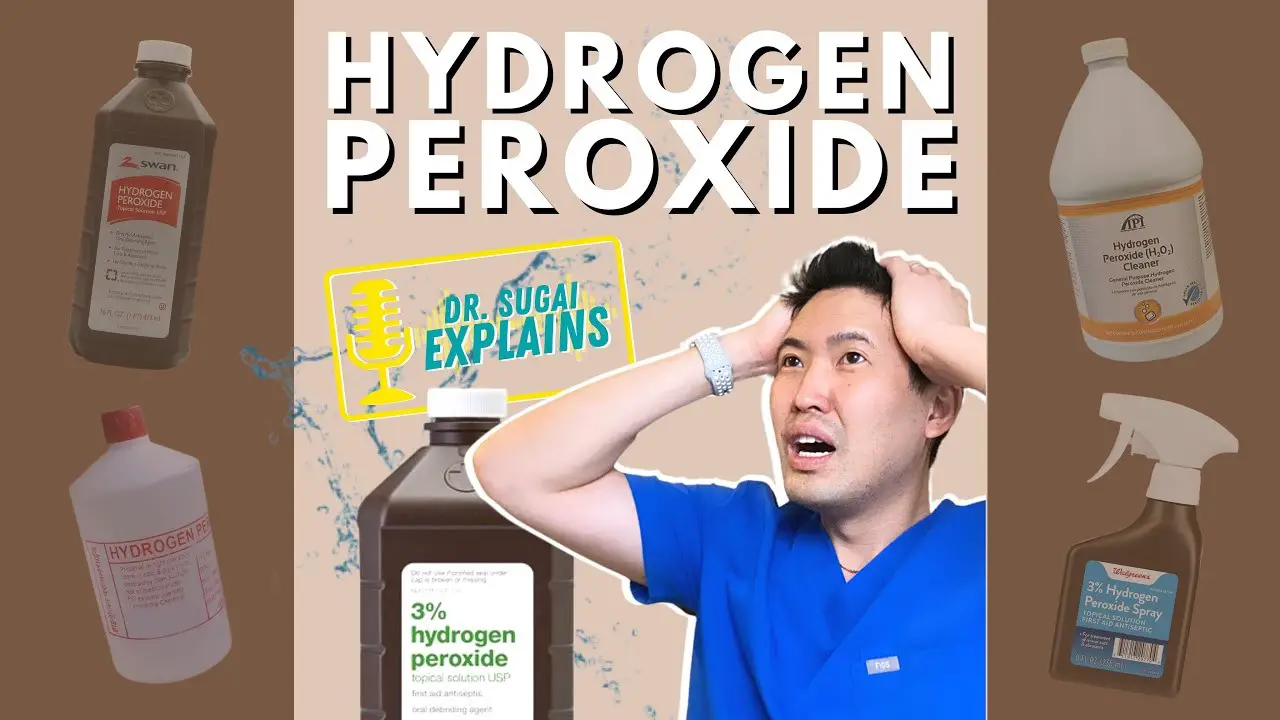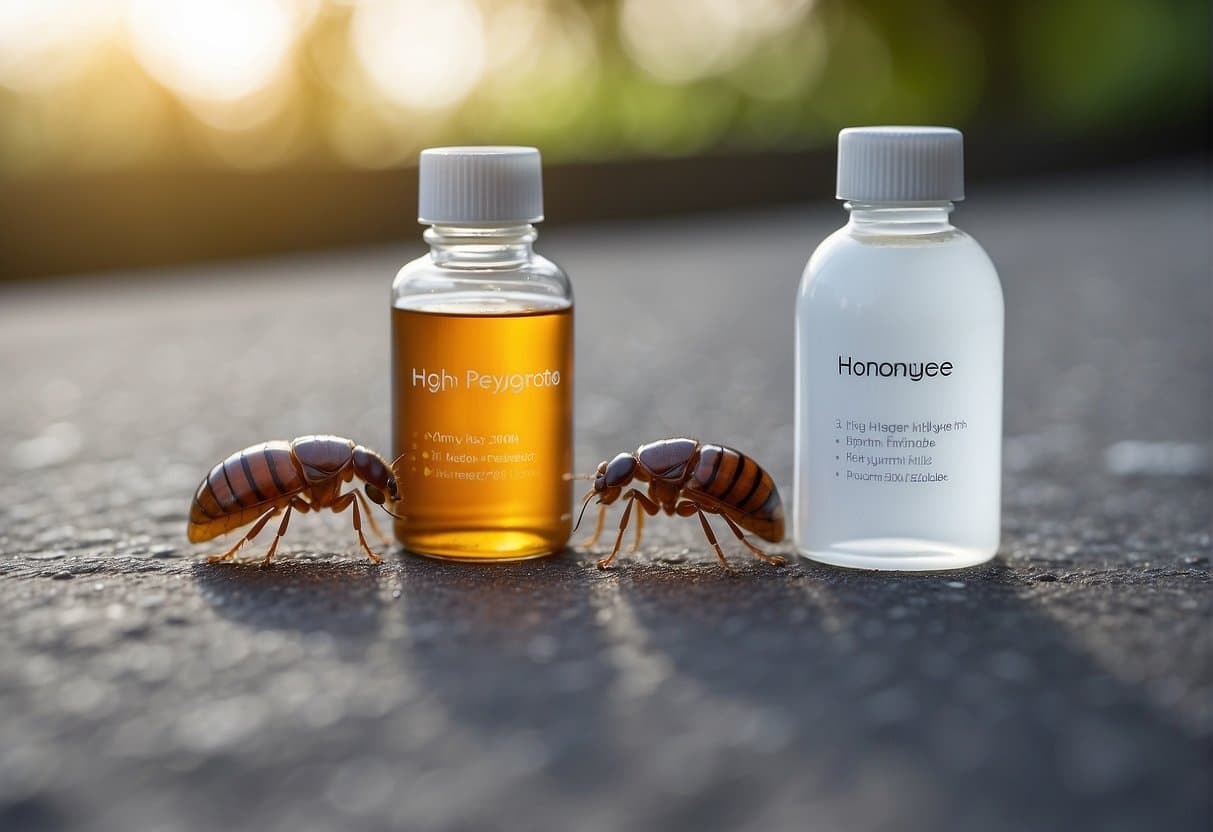Does Hydrogen Peroxide Kill Bed Bugs: Unveiling The Efficacy Of Common Household Solutions
Key Takeaways
While hydrogen peroxide can directly kill bed bugs, it may not be the most practical or secure approach. Crucial to consider are the potential risks of harm to belongings and health hazards before employing this method. In reality, alternative treatments and professional guidance might provide more dependable and safer solutions for eliminating these unwanted pests.
Understanding Hydrogen Peroxide

Hydrogen peroxide, a common household staple often found in pharmacies and labeled H2O2, might seem like a simple substance. However, its properties make it a valuable tool for various applications. As an oxidizer, hydrogen peroxide exhibits antiseptic and bleaching qualities, capable of killing bacteria through its aggressive oxygen-like behavior.
In its pure form, hydrogen peroxide is a colorless liquid with several uses including disinfecting surfaces, acting as a bleaching agent, and serving as a cleaning solution. But when it comes to tackling the pesky bed bug problem, the answer isn’t entirely straightforward. While hydrogen peroxide can technically kill bed bugs on contact, its effectiveness has limitations that need to be considered.
The Pros and Cons
Hydrogen peroxide is often touted as a reliable solution for eliminating bed bugs on contact. While it’s true that this common household item can effectively kill these unwanted pests, its limitations are just as important to consider. For instance, hydrogen peroxide might not be able to eliminate all life stages of bed bugs, including eggs, which can continue to pose a problem unless targeted specifically.
On the plus side, it’s readily available and relatively cost-effective, making it a convenient option for minor infestations. However, its non-toxic nature is only beneficial if used properly, as improper application could result in damage to fabrics and furniture due to bleaching. Furthermore, hydrogen peroxide might not be effective enough to tackle severe infestations, requiring more robust solutions.
As you navigate the world of bed bug control, it’s essential to strike a balance between using this solution wisely and exploring other options that can provide a more comprehensive approach. By doing so, you’ll be better equipped to effectively manage these pesky pests and restore your home to its original comfort.
Effectiveness Against Bed Bugs

When considering hydrogen peroxide as a home remedy to eliminate bed bugs, it’s essential to understand its effectiveness. While the oxidizing properties of hydrogen peroxide can indeed kill bed bugs on contact, it’s not a foolproof solution. In fact, the bleach-like nature of hydrogen peroxide has both advantages and limitations. On one hand, spraying hydrogen peroxide directly onto bed bugs can lead to their demise, making it a contact killer.
Moreover, it is non-toxic, rendering it safe for use around humans and pets. However, there are some caveats. Bed bug eggs, for instance, possess a protective layer that makes them resistant to the effects of hydrogen peroxide. Furthermore, a full-blown infestation may require more comprehensive measures than just spraying hydrogen peroxide willy-nilly. One must also consider the potential drawbacks, such as discoloration of fabrics and damage to furniture.
Lastly, for those pesky bed bugs hiding in hard-to-reach crevices, hydrogen peroxide might not be sufficient to reach and eliminate all hidden critters. While a hydrogen peroxide-soaked rag may help dispatch a few stray bed bugs, a total eradication of the infestation likely necessitates a more thorough approach.
Application Methods

To harness the potency of hydrogen peroxide against bed bugs, it’s crucial to employ correct application techniques that safeguard your home and family while maximizing its efficiency.
Safety Precautions
While hydrogen peroxide is a ubiquitous household disinfectant, it’s essential to exercise caution when using it. To avoid skin irritation, always wear protective gloves. Moreover, don’t forget to don eye protection to shield your eyes from potential burns. Additionally, ensure the room is well-ventilated to prevent inhaling fumes that can harm humans and pets.
Treatment Procedure
To tackle bed bug infestations effectively, start by preparing a solution that combines equal parts of hydrogen peroxide and hot water. According to expert advice, this 1:1 ratio is essential for achieving optimal results. Next, apply the solution directly to the affected areas using a spray bottle. This will not only kill the bed bugs on contact but also target those hiding in cracks and crevices.
After application, thoroughly inspect the area to identify any surviving bed bugs and reapply as needed. It’s crucial to remember that hydrogen peroxide has bleaching properties, so be sure to test the solution on a small, inconspicuous area first to avoid damaging surrounding surfaces.
Post-Treatment Actions
To effectively eliminate bed bugs from your space, it’s crucial to implement a multi-step approach. Following treatment, use a vacuum cleaner to thoroughly remove any dead bugs and eggs that have been eliminated by the spray. This ensures that no lingering infestation can take hold. In addition to vacuuming, wash all bed linens and clothing that came into contact with the treated area in hot water to further disinfect the space.
Finally, remain vigilant for signs of recurring bed bug activity over the coming days, being prepared to reapply treatment as needed to ensure a complete victory.
Comparison With Other Treatments

Bed bug treatments offer a range of approaches, from chemical-based methods to more unconventional solutions. While each option has its unique benefits and drawbacks, it’s crucial to consider the efficacy, safety, and compatibility with your home environment when selecting a treatment.
Chemical Treatments
When it comes to tackling bed bugs, chemical treatments like insecticides and pesticides are often employed. While they can be effective, their toxicity levels vary.
Insecticides commonly contain compounds that pose risks to both pets and human skin.
Pesticides, on the other hand, may include toxic chemicals, necessitating careful handling during application.
To minimize potential harm, it’s crucial to heed the manufacturer’s guidelines at all times.
This includes taking necessary precautions to protect yourself and your pets from unwanted exposure.
Heat Treatments
When it comes to eliminating bed bugs, heat treatment is a formidable method that capitalizes on the insects’ intolerance to high temperatures. By leveraging this weakness, homeowners and travelers alike can effectively eradicate these unwanted pests from their environment.
Two common ways to harness the power of heat are through dryer cycles and steam treatments.
The dryer method involves setting your appliance to its highest heat setting and treating clothing or luggage for an extended period. This approach is particularly useful for targeting bed bugs that have taken up residence in seams, folds, or other crevices.
Steam treatment offers a more targeted solution by utilizing high-pressure steam to reach into tight spaces and corners where bed bugs often hide.
By exploiting the fact that these pests can’t survive temperatures above 120°F, heat-based treatments provide a reliable means of elimination.
Non-Chemical Methods
When it comes to tackling bed bug infestations, it’s essential to explore non-chemical approaches that prioritize safety. Two effective methods worth considering include vacuuming as a starting point – although this may not be entirely comprehensive in its coverage – and utilizing Diatomaceous Earth, a powder that can be strategically sprinkled around the affected areas to dehydrate any bed bugs present.
It’s crucial to note that these chemical-free strategies are often safer for households with children and pets.
Home Remedies
While home remedies may not be the most reliable solutions, they often come at a lower cost. When it comes to tackling bed bug infestations, some common household items are touted for their ability to kill these unwanted pests. Two popular options include rubbing alcohol and hydrogen peroxide. However, it’s essential to temper your expectations with these methods, as they may not provide long-term results.
In fact, rubbing alcohol is thought to be effective only at killing bed bugs on contact, while hydrogen perxide can be lethal but is less potent than other home remedies and may cause damage to certain materials. As such, it’s crucial to use these home remedies in conjunction with other methods, rather than relying solely on them to solve the problem.
Preventative Measures

When it comes to combating bed bugs, it’s essential to strike a balance between preventing infestations and treating them effectively. A key part of this strategy is taking proactive measures to discourage these pests from settling into your furniture in the first place. By doing so, you can significantly reduce the need for costly and labor-intensive eradication methods, making the battle against bed bugs more manageable.
Regular Inspections
Regularly inspect your mattresses, box springs, and furniture thoroughly. Pay particular attention to cracks and crevices where bed bugs might be hiding. Look out for signs of adult bed bugs, which have a flat, brown, oval-shaped body, as well as tiny white eggs. When conducting inspections, don’t forget to check behind headboards, inside seams of bedding, and beneath furniture. A flashlight can be a valuable tool in illuminating hidden spaces.
If you suspect an infestation, consider seeking the expertise of professionals.
Maintaining Cleanliness
Maintaining a tidy home is crucial in minimizing the likelihood of encountering bed bug infestations. While it doesn’t guarantee total elimination, regular cleaning significantly reduces the risk.
Bedding and clothing are key areas to focus on when it comes to reducing bed bug populations. To effectively eliminate these unwanted pests, wash your bedding and clothing in hot water (above 120°F or 49°C) and dry them on the highest heat setting.
This ensures that any bed bugs hiding in crevices or fibers are killed.
In addition to washing and drying, it’s essential to cover your mattress with a protective layer to prevent bed bugs from entering or escaping. Regularly cleaning and disinfecting high-touch areas also helps limit the availability of hiding spots for these pests.
Protective Barriers
To effectively deter bed bugs, a physical barrier is essential, particularly when it comes to your sleeping area. One way to achieve this is by encasing your mattress and box spring with a bed bug-proof material. This type of enclosure traps any existing bed bugs inside and prevents new ones from burrowing their way out. The material itself should be impermeable to bed bugs, with features such as polyurethane offering excellent protection.
Additionally, the use of zippers on these encasements ensures that bed bugs cannot escape or re-enter your sleeping space. Furthermore, applying sealants to any cracks and crevices in walls and floors can help block potential entry points, providing an added layer of protection against these unwanted pests.
Health and Safety Considerations

Before exploring the possibility of using hydrogen peroxide to tackle a bed bug infestation, it’s essential to recognize the inherent health hazards and emphasize the need for meticulous handling practices. The well-being of yourself and others, including any household pets, must be prioritized above all else.
Potential Hazards
When it comes to using hydrogen peroxide, a common household antiseptic, it’s essential to exercise caution to avoid potential hazards. For both humans and pets, understanding the risks is crucial to prevent adverse effects. Some of the key concerns include: The skin can become irritated or even suffer chemical burns if exposed directly to hydrogen peroxide, especially with more concentrated solutions.
Inhaling the vapors released by hydrogen peroxide can be harmful, potentially causing lung damage and respiratory irritation. Furthermore, accidental eye contact can lead to severe irritation or permanent damage. With proper handling and use, these risks can be minimized, but it’s vital to be aware of them to ensure a safe experience.
Proper Handling
When working with hydrogen peroxide, it’s essential to follow specific guidelines to ensure safe handling. One crucial aspect is concentration: household-grade products typically have a 3% concentration, but higher percentages increase the risk of harm. To mitigate this, be mindful of the concentration you’re using and adjust your precautions accordingly.
Another vital consideration is personal protection.
Wear gloves to prevent skin contact and potential discoloration or irritation, even if you’re working with household-grade products.
Finally, ensure that the area is well-ventilated to minimize the risk of inhaling fumes. While hydrogen peroxide isn’t flammable, it can act as an oxidizer and should be used with caution.
Environmental Impact

Tackling bed bug infestations with hydrogen peroxide necessitates a multifaceted approach that balances the solution’s efficacy with its potential environmental implications. As a powerful oxidizing agent, hydrogen peroxide requires thoughtful consideration to ensure it is used responsibly and minimize any unintended consequences.
Ecological Effects
Hydrogen peroxide, often associated with its uses as a bleaching agent and antiseptic, may appear to be an eco-friendly choice for both home and environment due to its breakdown into water and oxygen. However, its properties as an oxidizer make it a potent tool in eliminating bacteria and bed bugs by disrupting their outer shell upon contact.
Although this makes it an effective pest control solution, concentrated forms can pose risks to other life forms and contribute to oxidative stress if not handled with care. Therefore, achieving a balance between efficient pest management and minimal ecological footprint is crucial.
Alternatives With Lower Risks
Although hydrogen peroxide is a relatively non-toxic solution, there are more eco-friendly and natural alternatives available. For those seeking prevention methods with minimal environmental impact, consider utilizing essential oils or diatomaceous earth. Additionally, consulting with a pest control professional can provide access to other treatments that prioritize the health of your surroundings.
It’s crucial to remember that managing bed bug problems efficiently requires finding a balance between effectiveness and environmental sustainability.
Professional Pest Control

As the battle against bed bugs wages on and DIY solutions like hydrogen peroxide fail to yield desired results, it’s often time to bring in the heavy hitters – professional pest control experts. With their extensive knowledge and arsenal of methods, they can provide a more comprehensive and effective solution to eliminate these pesky insects from your home for good.
When to Consult a Professional
In cases where infestations are severe or spreading rapidly, it’s crucial to consult with a pest control professional. The effectiveness of DIY methods, such as using hydrogen peroxide, is often short-lived and may not provide long-term solutions. Moreover, the misuse of over-the-counter treatments can lead to safety concerns. A trained professional ensures that treatment is applied safely and effectively, minimizing the risk of adverse effects.
Expectations from Professional Services
For an effective resolution to bed bug disturbances, a thorough inspection is performed to determine the extent of the infestation. A customized treatment plan is then developed, often combining both physical and chemical methods. With trained technicians applying the latest eradication techniques, you can rest assured that your home will be pest-free.
While hydrogen peroxide may provide temporary relief, it’s essential to consult a professional for a comprehensive solution and reclaim your peaceful living space.
Cost Considerations

When considering bed bug treatments, it’s essential to weigh not only the effectiveness but also the cost. Hydrogen peroxide is often touted as a budget-friendly option, but its financial implications should be carefully examined. In this context, we’ll delve into the monetary aspects of using hydrogen peroxide and compare the DIY approach to hiring a professional pest control service, providing a comprehensive understanding of the expenses involved in each method.
DIY vs. Professional Services
Hydrogen peroxide is often used as a DIY treatment for minor bed bug infestations due to its affordability and versatility. When applied to surfaces like furniture, mattresses, and carpets, it can kill bed bugs on contact. While it may not eliminate all life stages, such as eggs and larvae, it can still be an effective method for reducing the population. However, hydrogen peroxide is not without its drawbacks.
Its bleaching properties can damage certain materials, making it essential to test any surface before treatment. Additionally, while it can be a cost-effective option, it may not provide long-lasting results compared to professional treatments. Professional services, on the other hand, offer a more comprehensive and potent solution for bed bug removal. The estimated cost range varies depending on the severity of the infestation and the size of your home, with prices ranging from $300 to $5,000.
Professional pest control companies often employ methods designed to target all life stages and provide lasting results.
Budgeting for Home Treatments
When considering a DIY approach to financial reasons, it’s crucial to factor in the long-term costs of using hydrogen peroxide for bed bug treatment. The initial low cost is attractive, but don’t forget to account for the potential need for repeated applications to maintain effectiveness. Additionally, consider the possibility of property damage requiring replacement or repair, as well as the cost of supplementary products or equipment that may be necessary for a thorough treatment.
While hydrogen peroxide may seem like an affordable option upfront, its limitations and potential follow-up treatments should also be taken into account. Weigh your goals: are you seeking a temporary fix or aiming for a completely bed bug-free home? If the latter, ensure you’re prepared to invest time and resources in a comprehensive approach.
Final Thoughts
When it comes to tackling bed bug infestations, you may be considering the use of hydrogen peroxide as a potential solution. Previous research suggests that it can be effective in killing bed bugs on contact, but it’s essential to understand that this should not be relied upon as a standalone approach. Instead, consider hydrogen peroxide as an additional tool to complement your pest control strategy.
In terms of effectiveness, hydrogen peroxide has been shown to be capable of killing both adult bed bugs and larvae. However, its limitations include potential damage to surfaces due to its bleaching properties and reduced efficacy in destroying bed bug eggs.
To successfully eradicate bed bugs from your home, it’s crucial to adopt a layered approach that incorporates multiple methods.
While hydrogen peroxide can be a useful addition to this strategy, professional guidance is always recommended, especially when dealing with widespread infestations. Bed bugs are notorious for their resilience, and a multi-faceted approach often yields the best results.
When developing your plan of action against bed bugs, it’s essential to consider the pros and cons of each method, including hydrogen peroxide.
By weighing the advantages and disadvantages and integrating this solution prudently, you’ll be well-equipped to successfully reclaim your home from these pests.
Frequently Asked Questions
Here, we provide straightforward responses to frequently asked questions regarding the efficacy and application of hydrogen peroxide in combating bed bug infestations.
Is hydrogen peroxide effective at eliminating bed bugs on contact?
While hydrogen peroxide is indeed effective in killing bed bugs on contact, it’s essential to recognize that relying solely on this method won’t guarantee a comprehensive elimination of the infestation. The potency of hydrogen peroxide against bed bugs is limited, making it crucial to incorporate other strategies into your eradication plan.
Can bed bug eggs be eradicated using hydrogen peroxide?
Hydrogen peroxide, a common solution for killing adult bed bugs, falls short when it comes to eradicating their eggs. The eggs’ remarkable resilience demands additional approaches.
What are the immediate solutions for exterminating bed bugs?
To tackle the issue of bed bugs immediately, a combination of methods is necessary. Vacuuming, steam cleaning, and targeted chemical treatments are all effective solutions that require consistency to produce long-lasting results. A piecemeal approach won’t suffice; instead, it’s crucial to adopt a multi-faceted strategy that addresses the root of the problem.
How does diatomaceous earth compare to hydrogen peroxide in bed bug control?
Unlike its counterpart, hydrogen peroxide, diatomaceous earth offers a mechanical method for controlling pests, gradually dehydrating bed bugs through prolonged exposure. While not providing an immediate solution, this natural substance is a valuable component in any comprehensive pest control strategy.
Are household substances like vinegar or bleach successful in bed bug treatment?
While certain household items like vinegar and bleach may exhibit some effectiveness against bed bugs, it’s essential to note that their impact is often limited to immediate results, particularly when targeting adult bed bugs. Bleach, for instance, can be comparable in its effects to hydrogen peroxide. However, relying solely on these substances does not provide a comprehensive solution.
What professional-grade options are available for bed bug infestations?
For a comprehensive approach to pest control, professionals can opt for heat treatments that utilize controlled temperatures to eradicate unwanted insects. Another effective method is whole-room heat treatment, where the entire space is heated to a precise temperature to eliminate any existing pests. For even more persistent problems, industry-grade chemical insecticides can be used, providing long-term solutions and thorough eradication of infestations.






